 [Image: From Blend, where this post first appeared (translated into Dutch)].
[Image: From Blend, where this post first appeared (translated into Dutch)].
Rumor has it that a university outside Manchester teaches courses in mathematics and knot theory not inside comfortable, well-lit classrooms – the university has none – but down in the sewers, drains, valves, and storm tunnels built long ago beneath the city. That subterranean world of old Victorian brickwork is measured, sketched, and catalogued every year by new students; they spend whole weeks at a time mapping the curvature of spillway walls, graphing intersections of unexplored side-channels.
The results are then compared to diagrams of Euclidean geometry.
Manchester’s storm overflow sewers, the rumor goes, are actually topological models. They are knot theory in built form.
Other rumors claim that a former student of that program is now Chief Engineer for the city of Brisbane, Australia, where he leads the construction of new civic infrastructure; every sewer and spillway built there is designed by him alone. As a result, each time you flush a toilet in Brisbane, a bewildering and exhaustively contorted world of concrete knots and brick culverts comes to life, engineered to faultless precision, washing everyone’s waste out to sea.
Manifolds, loops, toroids, even prime number sequences: the entire history of Western mathematics can be derived from the sewers of Brisbane, monuments of urban plumbing.
 [Image: An artificial waterfall below the surface of the earth, photographed by Siologen].
[Image: An artificial waterfall below the surface of the earth, photographed by Siologen].
Perhaps even as you read this, meanwhile, two extraordinary photographers – under the names Siologen and Dsankt – are busy documenting these topologically complex systems built beneath cities throughout the UK, Australia, Canada, greater Europe, and beyond.
Siologen ranks tunnels according to their “connectivity, variation and age,” he explained in an email, and he travels literally around the world to explore new systems, collecting tetanus shots along the way…
Some drains, he claims, resemble subterranean car parts, as if glimpsing, from within, huge engines attached to the underside of the city, resonating with the echoes of unseen pumps. For instance, Sidedraught Induction, Siologen writes, referring to a system in Manchester, “reminds me of a Stromberg carburetor.”
 [Image: Tower of ladders and platforms, photographed by Siologen].
[Image: Tower of ladders and platforms, photographed by Siologen].
The drains, then, are even named – “the person who finds them, names them,” Siologen says – ranging from The Motherload to the ROTOR Bunker, to systems called Supercharger, Maze, Processor, Zardox, and The Works. Post that name, with photographs, onto enough websites, and eventually the label sticks. The sewers are a known geography.
Dsankt, meanwhile, actually boats his way into the underworld, boarding small skiffs in the rivers of outer Brisbane and following tides up intake valves, ducking beneath dangling scraps of sewage. His visits to the subcity are therefore carefully timed: should the waters rise faster than expected, both he and his boat will be crushed – shipwrecked in a world of abstract concrete rooms, slowly flooding.
 [Image: Black and white topology of intake valves, photographed by Dsankt].
[Image: Black and white topology of intake valves, photographed by Dsankt].
Apparently, Australian drains sound different than drains in the UK. In Sydney, for instance, there are “weird acoustics due to the jagged facets of rock in the walls,” Siologen explains, whereas London’s tunnels “sound wet” – and smell like shit. “Mostly it’s the sound of rushing water, with the clank of cars running over loose manhole lids and, of course, the splashing of people walking through.”

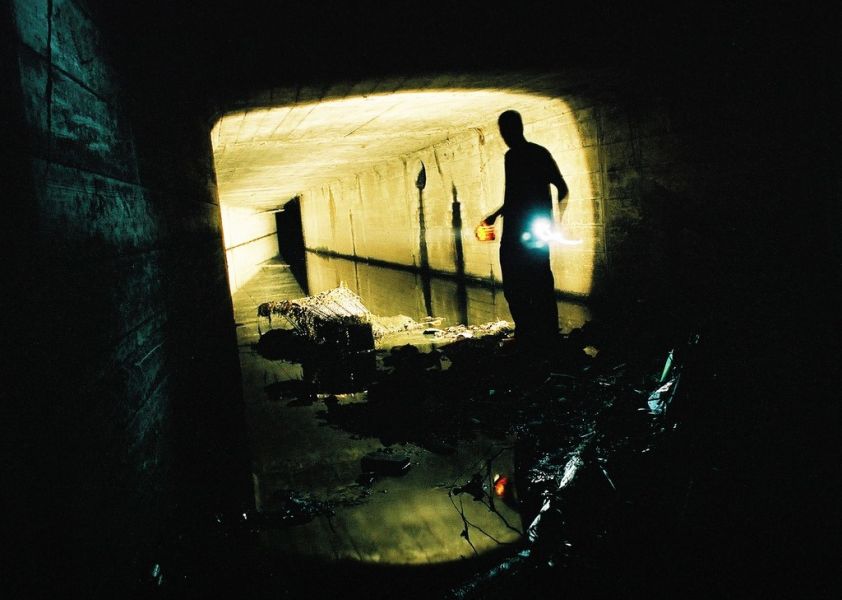 [Images: The human encounter with geometry by torchlight, photographed by Siologen].
[Images: The human encounter with geometry by torchlight, photographed by Siologen].
Unreliable sources suggest that the earliest Victorian sewer engineers were also trained to make musical instruments: thus many storm drains beneath London are designed like saxophones, tubas, and flutes. Distant changes in air pressure cause the whole system to shudder, whistling subliminally on the edges of the wind, a soundtrack for the city so beautiful it’s often hypnotic. If you wait long enough in certain alleys in Soho, you’ll hear it, droning beneath the rustle of crisp bags and trash.
It is rumored that the final, dying words of composer John Cage were: “Make sure they play my London piece… You have to hear my London piece…” He was referring, many now believe, to a piece written for the subterranean saxophony of London’s sewers.
 [Image: Instrumental curvature, photographed by Siologen].
[Image: Instrumental curvature, photographed by Siologen].
In any case, it is worth wondering what these tunnels will look like in five hundred years’ time. Will future archaeologists correctly conclude that all these drains, carved beneath the cities of the world, from Cairo to Shenzhen, were indeed textbooks in advanced knot theory? Or will those labyrinthine tunnels and networks of spillways simply appear to be some kind of prehistoric earthwork sculpture – Giza, Stonehenge, Easter Island, Heathrow – abandoned in the subsiding clay?
Perhaps the entire archaeological profession will be revolutionized by the discovery that alignments exist between the sewers of central Paris and the rising summer sun – lines of solstice and equinox that fill whole drains with light. Anthropologists will speculate that vast mirrors once stood at the junctions of empty corridors, illuminating the underworld bright as day. Post-graduate researchers will apply for funding to re-construct that subterranean maze of mirrors: reflections hitting reflections… hitting reflections.
Finally, on a summer solstice five hundred years from now, the archaeologists will stand, cameras in hand, as every sewer system in Europe begins to shine, light escaping from manhole covers, the surface of the earth faintly glowing.
 [Image: Shining tunnelwork of the future, photographed by Siologen].
[Image: Shining tunnelwork of the future, photographed by Siologen].
[Note: Thanks to Dsankt for putting me in touch with Siologen – and to Siologen for answering my questions and supplying the images for print. For more urban exploration, meanwhile, see London Topological; and under no circumstances miss the DIY Supervillain Hideout on Dsankt’s own Sleepy City. Finally, the image captions, above, are my own descriptions, not the actual titles of the photographs – which is why they’re so pretentious].
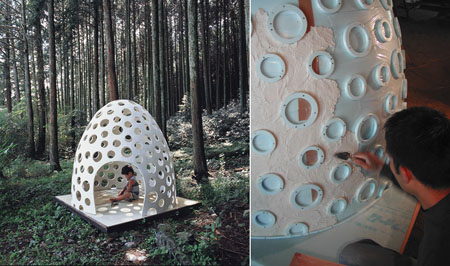 The pod is “delicately perforated,” made from “a combination of white cement, lightweight aggregate and glass fibre. This mixture was meticulously hand trowelled onto a carved styrofoam mould by skilled plasterers (the traditional Japanese plasterer’s art is known as sakan).” Meanwhile, we read, “[t]he perforations were created by attaching styrofoam rings to the dome-shaped master mould. When the concrete hardened, the mould was dismantled and removed.”
The pod is “delicately perforated,” made from “a combination of white cement, lightweight aggregate and glass fibre. This mixture was meticulously hand trowelled onto a carved styrofoam mould by skilled plasterers (the traditional Japanese plasterer’s art is known as sakan).” Meanwhile, we read, “[t]he perforations were created by attaching styrofoam rings to the dome-shaped master mould. When the concrete hardened, the mould was dismantled and removed.” [Image: From
[Image: From  [Image: An artificial waterfall below the surface of the earth, photographed by
[Image: An artificial waterfall below the surface of the earth, photographed by  [Image: Tower of ladders and platforms, photographed by
[Image: Tower of ladders and platforms, photographed by  [Image: Black and white topology of intake valves, photographed by
[Image: Black and white topology of intake valves, photographed by 
 [Images: The human encounter with geometry by torchlight, photographed by
[Images: The human encounter with geometry by torchlight, photographed by  [Image: Instrumental curvature, photographed by
[Image: Instrumental curvature, photographed by  [Image: Shining tunnelwork of the future, photographed by
[Image: Shining tunnelwork of the future, photographed by  [Image: From
[Image: From 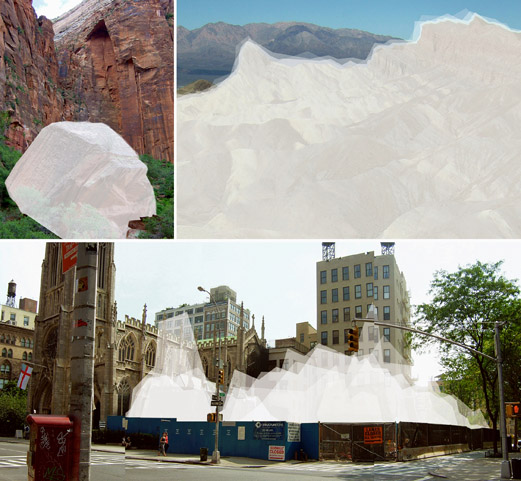 [Image: Abstract geology, by BLDGBLOG].
[Image: Abstract geology, by BLDGBLOG]. [Images: Litracon bricks, via
[Images: Litracon bricks, via 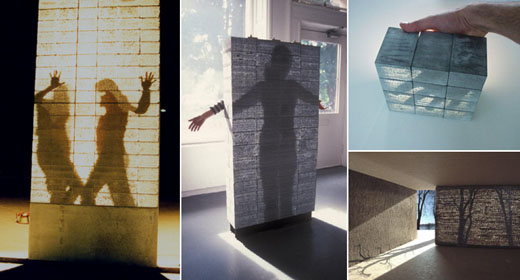 [Images: Litracon structures, via
[Images: Litracon structures, via  [Image:
[Image:  [Image:
[Image: 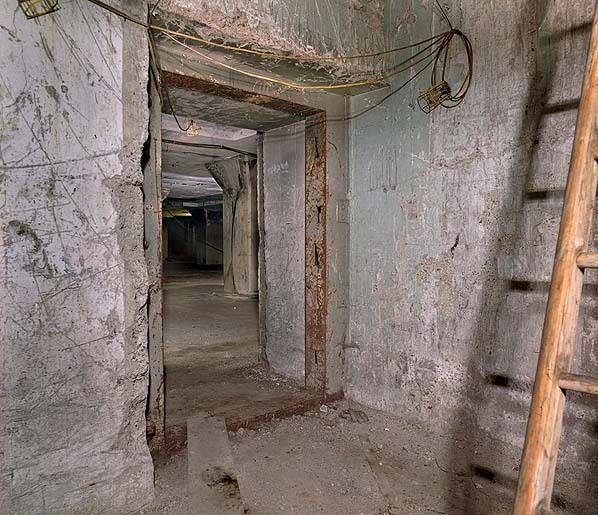
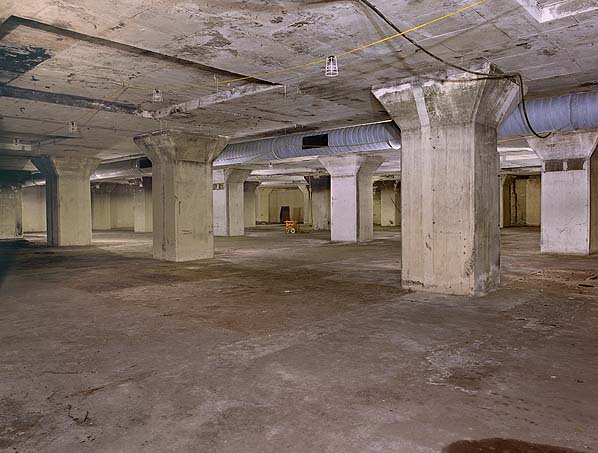
 [Images:
[Images: 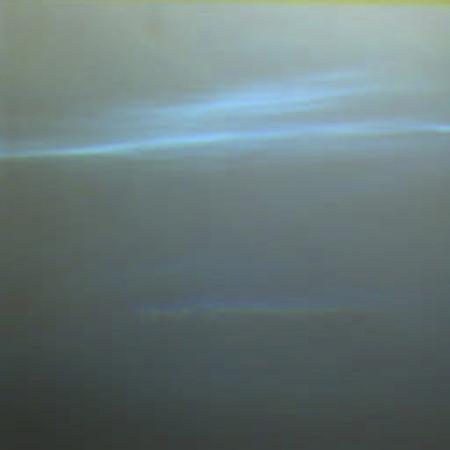 [Image: The
[Image: The  [Image: Zaha Hadid’s Abu Dhabi cultural center, “part spaceship, part organism,” according to
[Image: Zaha Hadid’s Abu Dhabi cultural center, “part spaceship, part organism,” according to  [Image: “Visitors survey an exhibition unveiling designs for a vast and architecturally ambitious cultural district planned for Saadiyat Island in Abu Dhabi, part of the United Arab Emirates.” Akhtar Soomro for
[Image: “Visitors survey an exhibition unveiling designs for a vast and architecturally ambitious cultural district planned for Saadiyat Island in Abu Dhabi, part of the United Arab Emirates.” Akhtar Soomro for